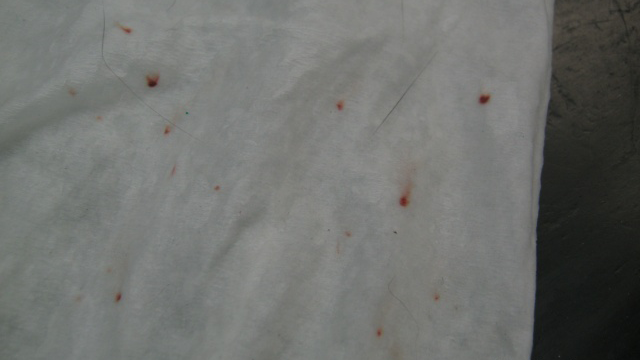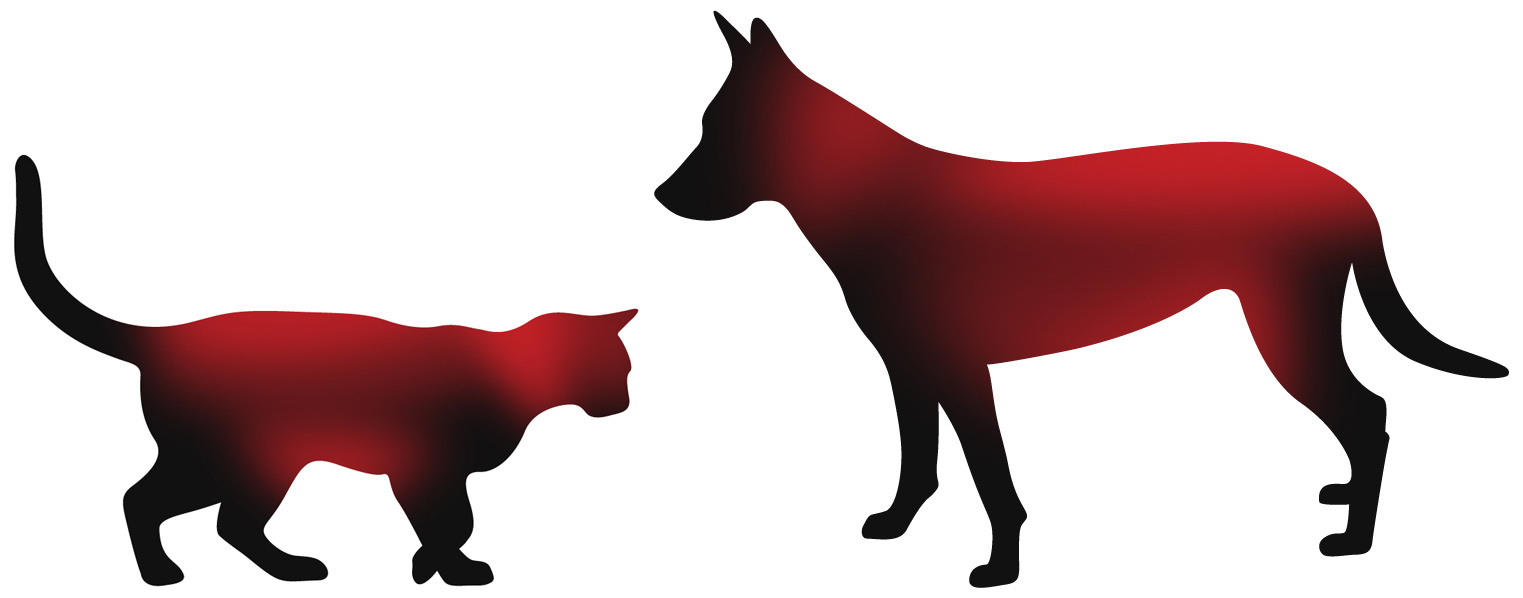
Img 1 A wet paper towel with black specks recovered from a cat. The red smears are caused from reconstituted fecal blood (flea dirt).
Summary
Using a flea comb is the the best way to check for fleas. A fine-toothed comb will collect and remove adults fleas and their feces from animal fur. The suspected feces will be dried, black specks. When the specks are rubbed on a wet paper towel, they will reconstitute into blood and smear red Img 1.
Details
Diagnosing a flea infestation involves finding adult fleas or their feces. Infestations are usually obvious, because adult fleas don’t leave their host.
How to Check for Fleas on Pets
Method 1: Flea Comb
Using a flea comb is the recommended way to identify fleas. Once an adult flea finds a host, it won’t leave of its own volition. Brushing cats or dogs with a fine-toothed flea comb will gather and remove fleas from their fur Vid 1. Even without combing, fleas may be visible on pets upon close inspection, especially on the abdomen where hair is thin. In one experiment, pet-owners saw fleas on 33% of infested animals. When a flea comb was used, detection went up to 66%.
Vid 1 Using a flea comb to find fleas on a dog.
Finding flea feces is more common than finding the actual insects, since the poop can’t move away from the comb. Thus, discovering feces on pets is the easiest way to diagnose an infestation.
Flea combs can also remove flea eggs from animals. However, the eggs are tiny and white, making them difficult to see. Plus, many of the non-sticky eggs fall off before or during combing.

Img 2 Heat map showing where fleas live on dogs and cats. Cats tend to have more fleas living on their head and neck, and dogs have more on their underside.
Fleas, and their feces, are most likely to be found on the neck, back, and belly of animals. They prefer living where it’s difficult for animals groom. On cats, the neck the in most commonly infested region. On dogs, their undersides are more commonly infested.
If adult fleas are found on a pet, then obviously the animal is infested. If black specks are found, it may be flea dirt, but further examination is needed (Method 2).
Method 2: Wet Paper Towel
Fleas excrete large quantities of feces onto pets while feeding. The ‘flea dirt’ is essentially undigested host blood. When it dries, the flea dirt looks like black pepper or black dandruff. It’s also been described as dark, reddish-brown debris.
Vid 2 Flea feces smearing red on a wet paper towel.
The flea feces can be shaken off of pets, or removed with a flea comb. Dark specks may be flea dirt, or they may be some other debris. A wet paper towel or cloth is useful to make a determination. Dried excreta will reconstitute into blood when placed on a moist paper towel. When rubbed, a rusty red stain will be left behind Vid 2. Wet cloth can also be wiped across a pet’s haircoat, and flea dirt will be picked up and smeared red on the cloth. Similarly, placing the black specks into a water droplet will turn the water blood-red.
Method 3: Pet Flea Spray
Using a flea comb is the recommended way to collect adult fleas from pets, as it’s cheap, fast, and chemical-free. However, an insecticidal flea spray for dogs or cats can also be used. Fleas will die and fall from the host, or they can be combed out. The dead species can identified and a diagnosis made.
How to Check for Fleas in Homes
Fleas lay eggs on their host, but the eggs aren’t sticky and fall off within a few hours. As a result, immature stages live in the environment, usually in rooms where pets rest, groom, and eat. Most live deep within carpeting.
Method 4: Vacuum & Gauze
Flea eggs, larvae, pupae, emerging adults, and feces can be collected from the floor with a vacuum cleaner. Use the vacuum’s hose and nozzle, and place a piece of gauze or a handkerchief within the nozzle attachment. This will prevent debris from entering the collection chamber. Vacuum around potential flea hot-spots. Then carefully remove the nozzle, and see if there are any fleas on the gauze. Adults can also be collected off of pets using this method.
Method 5: Flea Traps
After fully maturing, adult fleas emerge from carpets to find a host. Fleas traps, using light for attraction, can collect the adult fleas before they acquire a host. The traps should be placed in rooms where pets spend most of their time or where owners have observed fleas. A positive identification can then be made from the trapped specimens.
Method 6: White Socks
The white sock technique involves wearing knee-high white socks, and then walking around on carpets. Movement and warmth attract newly-emerged adult fleas in the carpeting, causing them to jump onto the socks. The fleas can then be easily observed on the white fabric.
Similarly, dragging a piece of white fabric along carpet or furniture may also attract adult fleas.
Finding Bites on People isn’t a Good Indicator
People who develop bites from an unknown insect will sometimes assume the culprits are fleas. However, finding bite lesions isn’t good enough for identification and diagnosis of fleas. Flea bites are indistinguishable from bites of other blood-feeding arthropods, such as bedbugs, mosquitoes, kissing bug, and mites. However, if bites are patterned in clusters of around 3, in lines or triangles, then the culprit is likely fleas or bedbugs. Other pests don’t display this bite pattern.
How to Check for Fleas in Yards
Fleas in yards can be found by walking around potential hot-spots. The source of fleas outdoors is often obvious. Fleas will quickly jump onto the lower legs. Pets also quickly acquire fleas in infested zones, which can be counted by combing. In one study, outdoor flea abundance was estimated by counting fleas crawling on the legs of researchers after 1 minute of exposure.
Tips for Detecting Fleas
Pets that are scratching or grooming themselves more than normal may have fleas. However, animals that are allergic to flea bites will excessively groom. Thus, they’re better removing fleas from their bodies. This may make finding fleas more difficult.
Check for fleas on dogs and cats before giving them a bath. Shampooing can remove the flea dirt and adult fleas from the animal’s body. This will make detection with a flea comb more difficult.
Checking for fleas is easiest on pets. Finding fleas in the environment is more difficult. And trying to make a determination from bites on humans is near impossible without seeing the actual pest that’s biting.




You must log in to post a comment. Log in now.